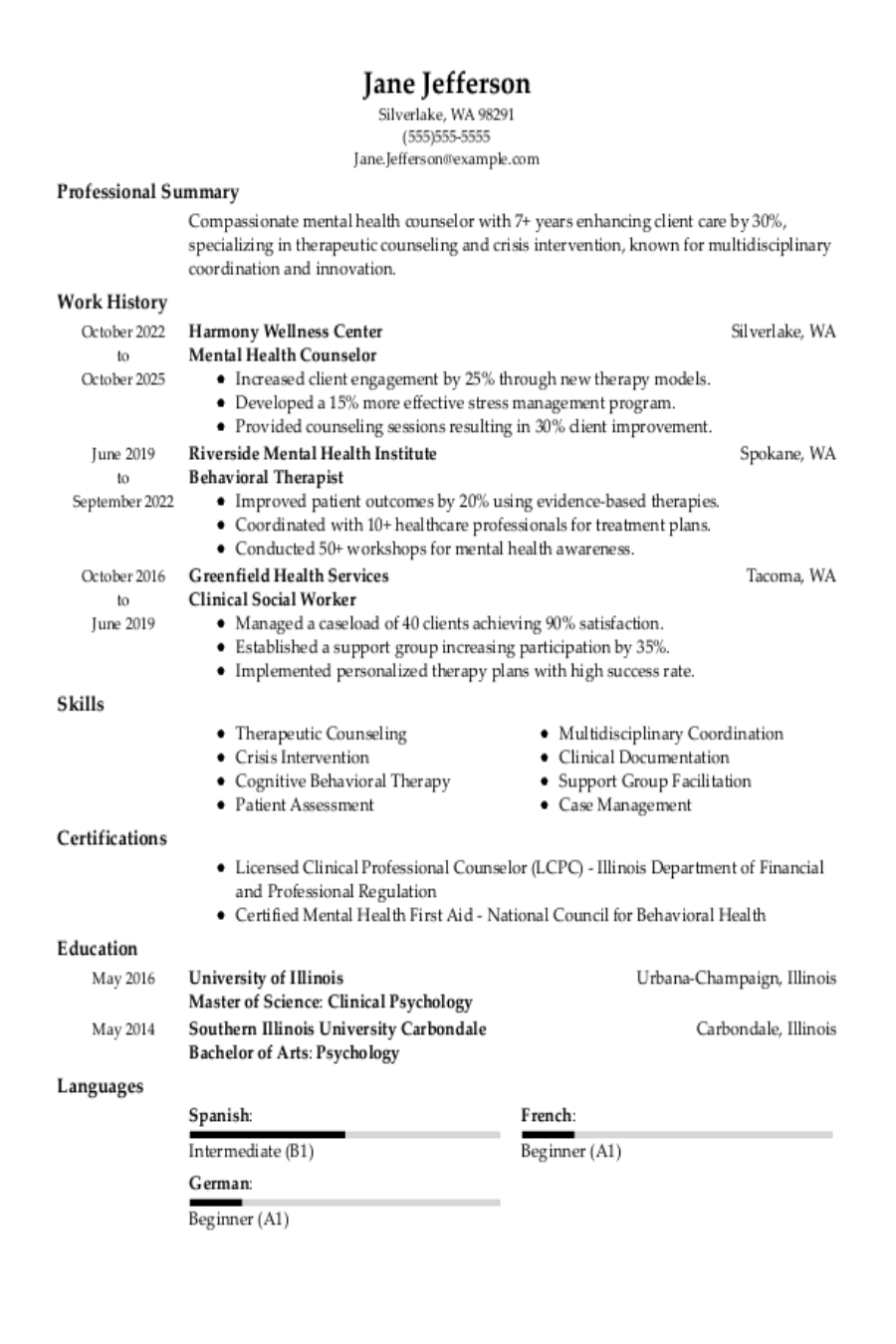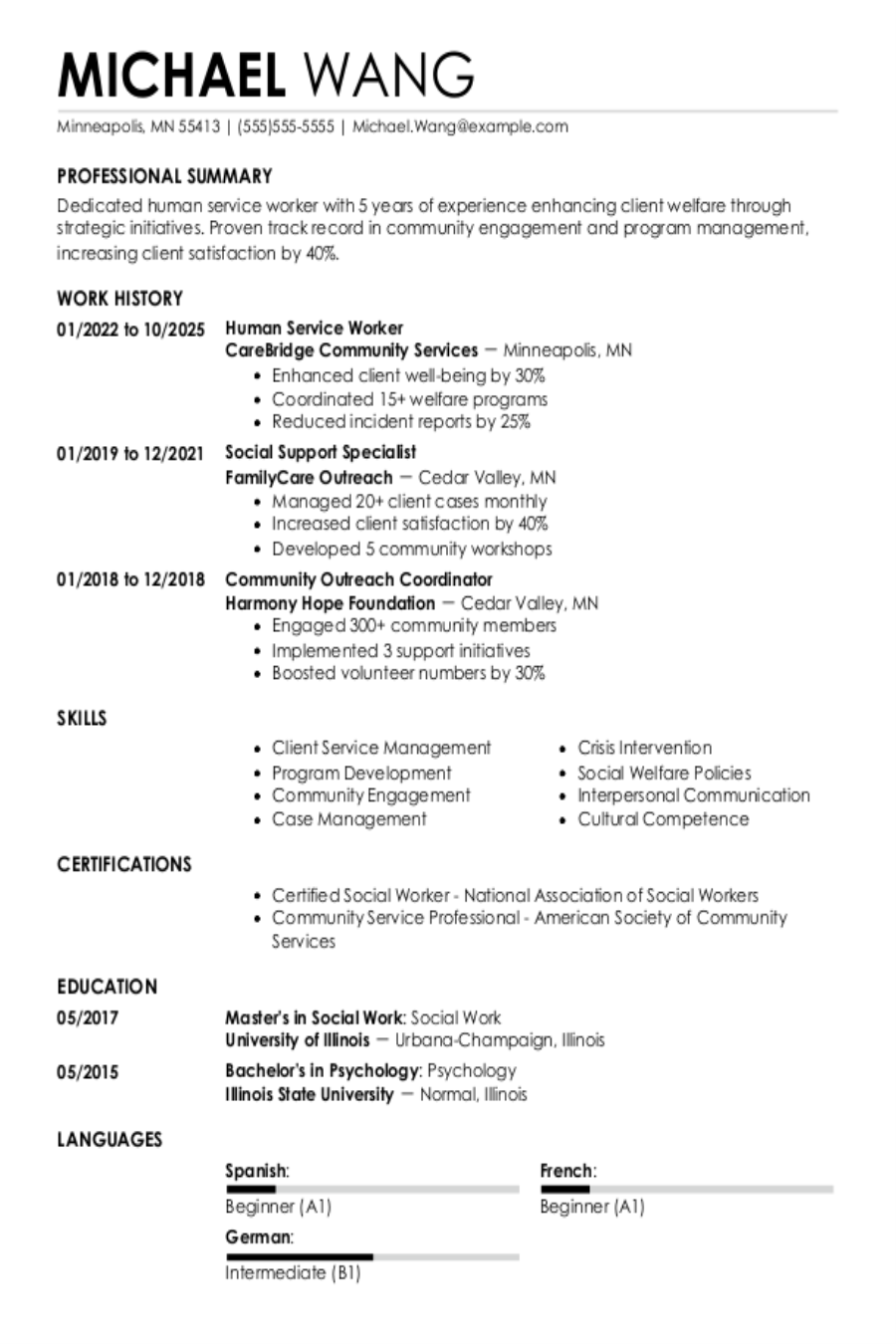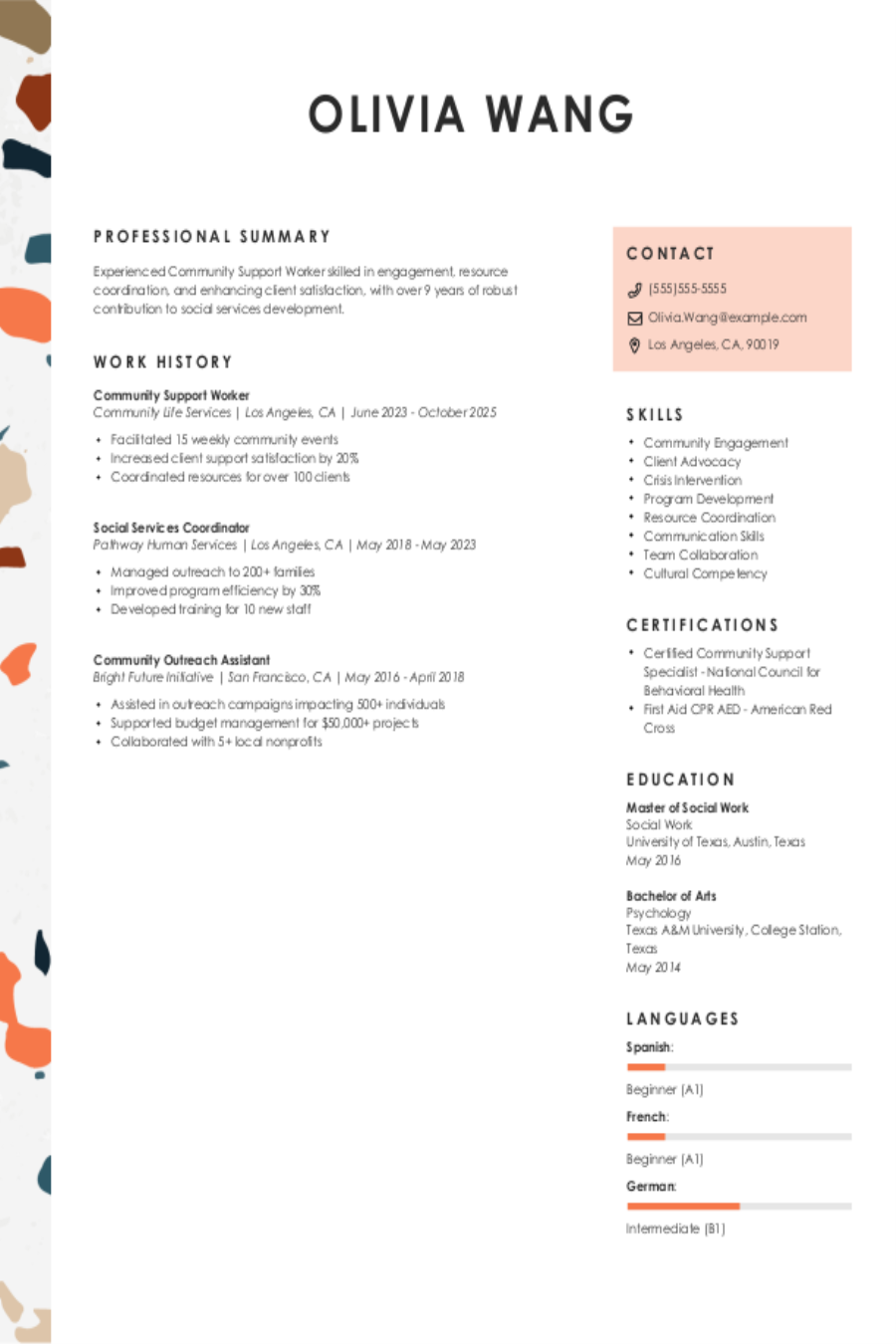Popular Orthodontist Resume Examples
Entry-level orthodontist resume
An entry-level resume for an orthodontist should highlight relevant education, clinical rotations, certifications, and hands-on training to show skill and preparedness for the role, even with limited direct experience.
Prominent education section: By putting their education toward the top of the resume, including a master's degree in orthodontics, this applicant shows that they are well-prepped to take on a role in the field.
Emphasis on soft skills: This job seeker's resume highlights strong soft skills, such as patient management and proactive problem-solving, which effectively compensate for limited experience. For example, their success in increasing patient satisfaction by 20% demonstrates their commitment to quality care.
Mid-career orthodontist resume
A mid-career orthodontist resume should emphasize a combination of patient management skills and ongoing professional development to demonstrate both competency and commitment to the field.
Powerful resume profile: The professional summary effectively highlights key achievements like improving patient satisfaction and implementing digital technologies, making it easy for recruiters and ATS to pinpoint relevant orthodontic expertise quickly.
Balanced skills section: The job seeker effectively highlights a mix of hard skills, such as advanced orthodontic techniques and digital imaging, alongside soft skills like patient care and team management, showcasing the applicant's comprehensive expertise.
Experienced orthodontist resume
An experienced orthodontist's resume should prioritize showcasing clinical expertise and a clear career arc, both of which illustrate professional growth and contributions to the field of orthodontics.
Reverse-chronological experience: The chronological resume format effectively showcases the extensive experience of the job seeker, clearly presenting their career progression through relevant roles that highlight significant achievements and contributions in orthodontics.
Organized template: The resume uses a polished template that features a professional header and an ATS-friendly resume layout, ensuring it is easily navigable for both hiring managers and automated applicant tracking systems.
No experience orthodontist resume
A resume for an applicant with no experience should highlight relevant coursework, internships, volunteer work, and any skills related to patient care and dental technology to showcase the job seeker's preparedness for the role.
Avoids jargon: Job seekers often feel the need to embellish their resumes with complex jargon or inflated descriptions of simple tasks. However, using straightforward language that clearly outlines their responsibilities can create a more authentic and effective impression on potential employers.
Emphasis on skills: Emphasizing clinical knowledge and patient communication highlights the job seeker's readiness to take on orthodontist role, showcasing their ability to contribute effectively despite limited hands-on experience.
More resume examples
Orthodontist Resume Template
Get started on your career journey with this orthodontist resume template—easily personalize it to highlight your skills and experiences that will attract potential employers.
Sophia Singh
Springfield, IL 62708
(555)555-5555
Sophia.Singh@example.com
Professional Summary
Orthodontist with 6 years of impactful experience. Expert in patient care management and treatment planning with notable achievements in clinic efficiency and financial budgeting.
Work History
Orthodontist
SmileWorks Dental - Springfield, IL
January 2022 - August 2025
- Improved patient satisfaction by 30%
- Managed 0K annual orthodontics budget
- Designed 200+ individual treatment plans
Dental Specialist
Precision Dental Group - Chicago, IL
January 2019 - December 2021
- Reduced treatment time by 25%
- Increased clinic efficiency by 40%
- Implemented new patient care protocols
Junior Dental Advisor
HealthySmile Dental - Chicago, IL
January 2017 - December 2018
- Generated 20% growth in patient referrals
- Assisted in 100+ complex surgeries
- Developed new dental hygiene programs
Skills
- Patient Care Management
- Orthodontic Procedures
- Dental Radiography
- Treatment Planning
- Financial Budgeting
- Clinic Efficiency Optimization
- Protocol Implementation
- Patient Satisfaction Improvement
Education
Master of Science Orthodontics
University of Southern California Los Angeles, California
May 2016
Bachelor of Science Dentistry
UCLA Los Angeles, California
May 2014
Certifications
- Certified Orthodontic Specialist - American Board of Orthodontics
- Advanced Dental Radiography - Dental Imaging Association
Languages
- Spanish - Beginner (A1)
- French - Intermediate (B1)
- German - Beginner (A1)
Writing Your Orthodontist Resume
Having explored effective resume examples, you're now equipped to learn how to write a resume. We'll guide you through each section and give you pro tips along the way.
List your most relevant skills
An effective skills section will include both technical skills—like skill in orthodontic software and treatment planning—and soft skills such as patient communication and empathy. These elements not only highlight your ability to perform the job but also demonstrate how well you connect with patients.
To ensure that your resume stands out to both human recruiters and applicant tracking systems (ATS), make sure to use keywords from the job listing. Look for specific terms related to orthodontics, like "braces," "aligners," or "patient care." Integrating these keywords naturally into your skills section will help present you as a perfect fit for the role, increasing your chances of landing an interview.
Example of skills on an orthodontist resume
- Proficient in creating personalized orthodontic treatment plans based on patient assessments
- Adept at using advanced imaging technology for precise diagnostics
- Strong communicator, effectively educating patients about procedures and care
- Compassionate team player, fostering a supportive environment for patients and staff
A well-crafted skills section should showcase both hard and soft skills. Hard skills demonstrate technical expertise, while soft skills highlight the ability to communicate and collaborate effectively with patients and colleagues, which is essential for a successful orthodontist.
Highlight your work history
The work experience section should highlight the results you've achieved in past roles, focusing on specific outcomes like successful treatment plans or improved patient satisfaction scores. This approach showcases how effectively you've applied your skills.
Each job entry should include essential details such as your title, the name of the dental practice or clinic, and the dates you were employed. This information quickly helps potential employers gauge your background and experience level. Remember to detail not just what you did but also how well you did it—quantifying achievements whenever possible adds credibility and interest.
Example of an orthodontist work experience entry
- Orthodontist
Smile Innovations - Los Angeles, CA
June 2019 - Present - Diagnose and develop treatment plans for patients with dental irregularities, improving smiles with a 95% success rate in patient satisfaction surveys
- Use advanced orthodontic technology, including 3D imaging and digital scanning, to create precise aligner fittings that reduce average treatment time by 20%
- Educate patients and families on oral hygiene practices and the importance of compliance during treatment, contributing to a significant decrease in missed appointments by 30%
- Collaborate with dental professionals to ensure comprehensive patient care and timely referrals while maintaining adherence to regulatory standards
- Mentor junior associates in orthodontic techniques and practice management, fostering a supportive learning environment that improved team efficiency by 15%
An outcomes-focused experience section is essential for showcasing your effectiveness as an orthodontist. By highlighting specific achievements, such as successful treatment plans or patient satisfaction rates, you demonstrate your impact on patient care and practice growth. This approach not only captures the attention of potential employers but also provides a compelling narrative of your professional contributions.
Include your education
The education section of your orthodontist resume should clearly present your academic credentials in reverse-chronological order, starting with your most recent degree. Include all relevant degrees, such as your Doctor of Dental Surgery (DDS) or Doctor of Medicine in Dentistry (DMD), and omit high school diplomas if you hold a higher qualification. Highlight any honors received to improve the credibility of this section.
If you are currently pursuing further education or have not yet completed a degree, indicate your highest level achieved along with an expected graduation date. Including bullet points that highlight relevant coursework or significant research projects related to orthodontics is beneficial. This strategy is particularly helpful for those who are students or recent graduates, as it showcases an active engagement in the field.
Common certifications for an orthodontist resume
- Board Certified Orthodontist (BCO) – American Board of Orthodontics (ABO)
- Diplomate of the American Board of Orthodontics (DABO) – American Board of Orthodontics (ABO)
- Certified Invisalign Provider – Invisalign
- Fellowship in the World Federation of Orthodontists (FWFO) – World Federation of Orthodontists
Showcase publications and research
As an orthodontist, showcasing your publications section on your resume is essential as they highlight your expertise and commitment to advancing the field. Publications not only reflect your knowledge but also demonstrate your ability to contribute meaningfully through research and clinical insights. They serve as a testament to your dedication to evidence-based practice, which is important in gaining the trust of patients and peers alike.
You should create a dedicated publications section if you have several noteworthy works. This approach allows you to present them prominently, improving your professional profile. Conversely, if you possess only one or two publications, consider integrating them into sections like education or relevant experience for a more concise presentation. Ensure proper formatting that adheres to citation standards common in dentistry.
Example of a publications section
- Smith, J. & Doe, R. (2024). "Innovations in Orthodontic Treatment Techniques". Journal of Orthodontics, 18(1), 23-36.
- Johnson, A., Brown, T., & Lee, S. (2023). "The Role of Technology in Modern Orthodontics". Orthodontic Advances, 10(2), 55-70.
- Research Contributor, Dental Health Initiative (2022–2023). "Research Contribution: Impact of Early Orthodontic Intervention on Patient Outcomes". Analyzed patient data from two clinical studies on early intervention..
- Chen, H. & Johnson, A. (2022). "Co-authored Guidelines for Effective Patient Communication in Orthodontics". Patient Care Journal, 15(4), 100-115.
Sum up your resume with an introduction
Your resume's opening profile functions as a strategic preview of your professional capabilities, designed to capture employer attention and encourage further review of your credentials. This section can be the difference between standing out in a competitive job market or blending in with other applicants.
Choosing between a professional summary and resume objective reflects your current position in your career journey. Established professionals can maximize summaries by showcasing quantifiable results, leadership experience, and deep industry knowledge gained over time. Recent graduates and career switchers are better positioned with objectives that highlight educational achievements, relevant competencies, and genuine passion for their chosen field. in their profiles.
Professional summary example
Accomplished orthodontist with over 10 years of experience in delivering high-quality dental care and transforming smiles. Demonstrated expertise in diagnosing malocclusions, designing effective treatment plans, and using advanced technology for optimal results. Committed to improving patient satisfaction through exceptional communication and personalized care, ensuring each individual feels supported throughout their orthodontic journey.
Resume objective example
Enthusiastic orthodontist eager to apply a solid foundation in dental care and patient communication to improve patient experiences in a progressive practice. Looking to use skills in treatment planning and digital imaging to support comprehensive orthodontic solutions, fostering healthy smiles and long-lasting relationships with patients.
As an orthodontist applicant, it's essential to kick off your resume profile with your job title. This strategy ensures that employers quickly recognize your professional identity and understand what you bring to the table, whether you opt for a professional summary or an objective statement.
Add unique sections to set you apart
Including optional sections in your resume can effectively highlight your unique qualifications as an orthodontist. These sections allow you to stand out by showcasing attributes that make you a well-rounded job seeker.
By incorporating relevant hobbies or volunteer experiences, you provide insight into your professional persona. This not only displays your commitment to the field but also highlights personal values such as community service and lifelong learning. Employers appreciate seeing applicants who actively engage in activities outside of their clinical duties, as it often reflects strong interpersonal skills and a passion for helping others, which are vital in orthodontic practice.
Three sections perfect for a orthodontist resume
- Clinical experience: Your clinical experience highlights your practical skills and patient interaction. Include details about the types of orthodontic treatments you've performed, the diversity of cases you've handled, and any techniques that showcase your skill.
- Continuing education: Ongoing education reflects your commitment to staying updated with industry advancements. List relevant courses, certifications, or workshops you’ve attended, focusing on new technologies or methodologies in orthodontics.
- Community involvement: Engagement in community initiatives showcases your dedication beyond clinical practice. Highlight volunteer work in dental outreach programs or educational seminars where you promote oral health awareness.
5 Resume Formatting Tips
- Choose a format that matches your career stage.
When crafting your resume as an orthodontist, consider your career level and experience. If you have extensive experience, a chronological resume format highlights your professional journey effectively. For those just starting out or transitioning from another field, a functional resume focuses on skills rather than job history. Alternatively, a combination resume showcases both your experience and relevant skills, providing a well-rounded view of what you offer.
- Pick a smart resume template.
Using a resume template will ensure your document is properly formatted. A well-structured template allows hiring managers to quickly grasp your qualifications at a glance. If you decide to create your own layout, focus on simplicity and select fonts that are compatible with applicant tracking systems (ATS) to boost your chances of getting noticed.
- Use an appropriate font.
Opt for a professional font like Helvetica, Georgia, or Verdana. These fonts are easy on the eyes, and ensure your qualifications stand out, making a positive impression on potential employers in the orthodontic field.
- Use consistent formatting.
Align your resume to the left and maintain uniform margins to ensure it looks polished and professional, making a strong first impression on potential employers.
- Keep your resume to one or two pages.
Resumes should be one page long. If you have extensive experience, extending to two pages is acceptable. Regardless of the length, ensure your content is clear and focused on the key details that highlight your qualifications effectively.
Tools for Your Job Search
Are you preparing to apply for that coveted orthodontist position? Before you hit submit, consider using our ATS Resume Checker. This invaluable tool provides insights into how your resume performs with the automated systems that many dental practices use for initial screening, ensuring your application gets noticed.
Looking to take your resume to the next level? Our AI Resume Builder can help! It offers tailored recommendations specific to your orthodontic expertise and features professionally designed templates that effectively showcase your qualifications and experience to prospective employers.
Frequently Asked Questions
Last Updated: August 23, 2025
Absolutely. A cover letter adds depth to your resume and offers an additional platform for you to communicate with potential employers. It's your opportunity to highlight your passion for orthodontics and detail how your specific skills and experiences make you a perfect fit for the role. Don’t skip this step - write a cover letter that improves your application.
For a quick and efficient solution, consider using our AI Cover Letter Generator, which allows you to create tailored cover letters in just minutes. You'll also find various cover letter template options available that perfectly align with your resume, ensuring a polished presentation of your qualifications.
A CV (curriculum vitae) is generally more extensive and detailed than a resume. While resumes typically are confined to one or two pages, CVs can span several pages, encompassing in-depth information about your academic qualifications, research experiences, publications, and professional accomplishments.
You should use a CV when applying for specialized positions in academia, science, law, or medicine. If you find yourself needing a CV for your application, our online CV Maker provides the perfect solution to swiftly create a tailored document. Choose from our diverse range of CV templates, designed for various industries and career stages, to make your application stand out.
Absolutely, essential skills like "patient management" and "dental imaging" are important on orthodontist resumes. It's also beneficial to examine job descriptions for more specific keywords and phrases that can improve your application.
To improve your networking skills as an orthodontist, regularly connect with former colleagues and dental professionals. Consider joining associations like the American Association of Orthodontists to broaden your network. Additionally, keep your LinkedIn profile current so you can effectively engage with industry trends and opportunities.
As you gear up for your orthodontist interview, take time to practice job interview questions and answers. This preparation not only boosts your confidence but also equips you to tackle any unexpected queries that may arise during the conversation.
To excel as an orthodontist, actively pursue upskilling through specialized certifications and training programs. Join professional associations to network and stay informed about industry advancements. Regularly read relevant publications and participate in workshops or webinars to keep your knowledge fresh and demonstrate your commitment to professional growth.
Was this information helpful? Let us know!
Hailey is a career advice writer dedicated to helping job seekers excel in their careers.
More resources

63% Expect AI’s Role in Compensation to Grow Significantly in the Next 5 Years
Resume Now s latest report examines how workers are responding...

How to Include Research Skills on a Resume: 40+ Examples
Check out our guide to understand what research skills are and...

How To Write a CV: The Ultimate Guide for 2025
Here is a complete and comprehensive guide to writing a CV ev...

Mental Health Counselor Resume: Examples and Templates for 2025
Was this information helpful? Let us know ...

Human Service Worker Resume: Examples, Templates & Tips for 2025
Explore a range of human service worker resume examples design...

Community Support Worker Resume: Examples, Templates & Tips
Creating a community support worker resume is easier with the ...

